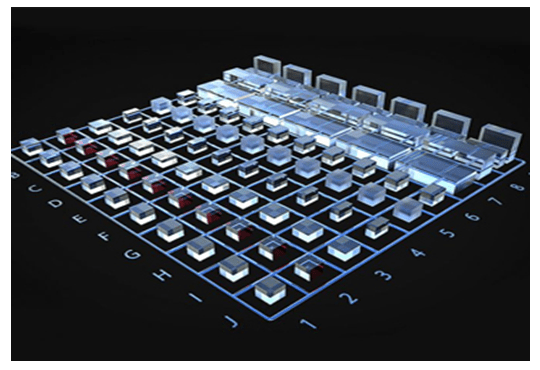Optical interconnect technology is the successor to conventional electrical interconnects. Particularly in telecommunications, it was an obvious and essential step from electrical to optical interconnects to cope with the ever-growing demand for higher bandwidths, transfer speeds, and the necessity to handle large volumes of data between data centers around the world. Today, data traffic is still growing dramatically, e.g., through a tremendous increase in cloud computing, 5G, video services or internet-of-things applications, to name but a few.
Fiber-optic solutions
The optical interconnect between different hardware from short to very long distances is mostly based on optical fibers. Bundled as cables, they bridge up to thousands of miles in telecommunications, or just hundreds of yards in a computer network within a building.
Nowadays, optical interconnects are standard in data centers and broadband telecommunication networks. Commonly, fiber-optic cables are physically connected to transceivers with integrated lasers and detectors. They are capable of both transmitting and receiving an optical signal. Transceivers are available with varying form factors, specifications, speeds, and protocols.
Choosing the right transceiver for your application mainly depends on the type of data to be transported, and what speed and distance is best suited. Typical application areas for fiber-optic communication are intra- and inter-datacenter interconnects, FTTx (the last mile to premises), metropolitan optical fiber networks that interconnect services beyond FTTx, submarine communications cables on the seabed for very long distances, and many more.
Free-space interconnection
Free-space optical interconnect is another option for optical telecommunication or network connections. Its application is rather limited to special use cases where optical fibers are not applicable or are too expensive.
In free-space optical interconnects, the light signal propagates free in the atmosphere, space, or vacuum instead of being coupled into an optical fiber cable. It is a straight point-to-point link as free-space transmission cannot be bent in direction like a fiber optical cable and it is generally collimated with lenses or mirrors. In terrestrial applications, it has a maximum range of up to around two miles. Limiting factors are the weather conditions which cause scattering and damping of the signal, environmental light, and atmospheric distortions.
Long-distance free-space optical interconnects were established in some non-commercial cases for ground-satellite links. Also, satellite-to-satellite communication was realized mainly for demonstration purpose. Both approaches are aimed to be commercialized in the future.
Interconnects on the miniature level
Interconnection on the very small scale takes place in integrated circuits. Metal interconnects have become the main performance bottleneck and therefore optical interconnect is one possible option for short-reach communication such as intra-chip, chip-to-chip, processor-to-memory, or board-to-board communication.
The main advantages of using light instead of wires is a considerably higher bandwidth while generating less heat across the interconnection link. The challenge is that chip-scaled optical components need to be highly integrated as the size of integrated logic circuitry rushes towards the nanometer regime. Optical transceiver technology based on novel optoelectronic device technology may offer future solutions.
Components for optical interconnects
Besides the actual optical interconnect technologies, it is crucial how data is transferred via the optical interconnects. Here, wavelength-division multiplexing is the common approach today. Optical filters are essential components to multiplex or de-multiplex wavelength signals in optical networks. Iridian offers a wide choice of high-quality telecom filters for example for CWDM, DWDM, FTTx, free space and more. Please contact us for custom requirements and quotes on our telecom filters.



